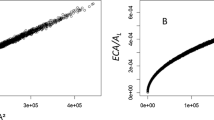Abstract
Recent studies have used transition matrix elasticity analysis to investigate the relative role of survival (L), growth (G) and fecundity (F) in determining the estimated rate of population increase for perennial plants. The relative importance of these three variables has then been used as a framework for comparing patterns of plant life history in a triangular parameter space. Here we analyse the ways in which the number of life-cycle stages chosen to describe a species (transition matrix dimensionality) might influence the interpretation of such comparisons. Because transition matrix elements describing survival (“stasis”) and growth are not independent, the number of stages used to describe a species influences their relative contribution to the population growth rate. Reduction in the number of stages increases the apparent importance of stasis relative to growth, since each becomes broader and fewer individuals make the transition to the next stage per unit time period. Analysis of a test matrix for a hypothetical tree species divided into 4–32 life-cycle stages confirms this. If the number of stages were defined in relation to species longevity so that mean residence time in each stage were approximately constant, then the elasticity of G would reflect the importance of relative growth rate to λ. An alternative, and simpler, approach to ensure comparability of results between species may be to use the same number of stages regardless of species longevity. Published studies for both herbaceous and woody species have tended to use relatively few stages to describe life cycles (herbs: n=45, \(\bar x = 6.16 \pm 4.63\); woody plants: n=21, \(\bar x = 8.38 \pm 3.57\)) and so approximate this approach. By using the same number of stages regardless of longevities, the position of species along the G-L side of the triangular parameter space largely reflects differences in longevity. The extent of variation in elasticity for L, G and F within and between species may also be related to factors such as successional status and habitat. For example, the shade-tolerant woody species, Araucaria cunninghamii, shows greater importance for stasis (L), while the gap-phase congener species, Araucaria hunsteinii, shows higher values for G (although values are likely to vary with the stage of stand development).
Similar content being viewed by others
References
Caswell H (1978) A general formula for the sensitivity of population growth rate to changes in life history parameters. Theor Popul Biol 14: 215–230
Caswell H (1982) Stable population structure and reproductive value for populations with complex life cycles. Ecology 63: 1223–1231
Caswell H (1986) Life cycle models for plants. Lect Math Life Sci 18: 171–233
Caswell H (1989) Matrix population models. Sinauer, Sunderland, Mass
Cochran ME, Ellner S (1992) Simple methods for calculating agebased life history parameters for age-structured populations. Ecol Monogr 62: 345–364
Enright NJ (1982) The ecology of Araucaria species in New Guinea. III. Population dynamics of sample stands. Aust J Ecol 7: 227–237
Fnright NJ, Ogden J (1979) Applications of transition matrix models in forest dynamics: Araucaria in New Guinea, and Nothofagus in New Zealand. Aust J Ecol 4: 3–23
Enright NJ, Watson AD (1991) A matrix population model analysis for the tropical tree, Araucaria cunninghamii. Aust J Ecol 16: 507–520
Enright NJ, Watson AD (1992) Population dynamics of the nikau palm Rhopalostylis sapida (Wendl. et Drude), in a temperate forest remnant near Auckland, New Zealand. NZ J Bot 30: 29–43
Gotelli NJ (1991) Demographic models for Leptogorgia virgulata, a shallow water gorgonian. Ecology 72: 457–467
Grime JP (1977) Evidence for the existence of three primary strategies in plants and its relevance to ecological and evolutionary theory. Am Nat 111: 1169–1194
Grime JP (1979) Plant strategies and vegetation processes. Wiley, Chichester
Grime JP, Hodgson JG, Hunt R (1988) Comparative plant ecology. Allen and Unwin, London
Kroon H de, Plaiser A, Groenendael J van, Caswell H (1986) Elasticity: the relative contribution of demographic parameters to population growth rate. Ecology 67: 1427–1431
Meagher TR (1982) The population biology of Chamaelirium luteum, a dioecious member of the lily family: two-sex population projections and stable population structure. Ecology 63: 1701–1711
Mesterton-Gibbons M (1993) Why demographic elasticities sum to one: a postscript to de Kroon et al. Ecology 74: 2467–2468
Moloney KA (1986) A generalized algorithm for determining category size. Oecologia 69: 176–180
Moloney KA (1988) Fine-scale spatial and temporal variation in the demography of a perennial bunchgrass. Ecology 69: 1588–1598
Sarukhán J, Gadgil M (1974) Studies on plant demography: Ranunculus repens L., R. bulbosus L. and R. acris L. III. A mathematical model incorporating multiple modes of reproduction. J Ecol 62: 921–936
Silvertown J, Franco M (1994) Plant demography and habitat: a comparative approach. Plant Species Biol 8: 67–73
Silvertown J, Franco M, McConway K (1992) A demographic interpretation of Grime's triangle. Funct Ecol 6: 130–136
Silvertown J, Franco M, Pisanty I, Mendoza A (1993) Comparative plant demography: relative importance of demographic components to the finite rate of increase in perennial plants. J Ecol 81: 465–476
Stearns SC (1992) The evolution of life histories. Oxford University Press
Vandermeer J (1978) Choosing category size in a stage projection matrix. Oecologia 32: 79–84
Author information
Authors and Affiliations
Rights and permissions
About this article
Cite this article
Enright, N.J., Franco, M. & Silvertown, J. Comparing plant life histories using elasticity analysis: the importance of life span and the number of life-cycle stages. Oecologia 104, 79–84 (1995). https://doi.org/10.1007/BF00365565
Received:
Accepted:
Issue Date:
DOI: https://doi.org/10.1007/BF00365565




